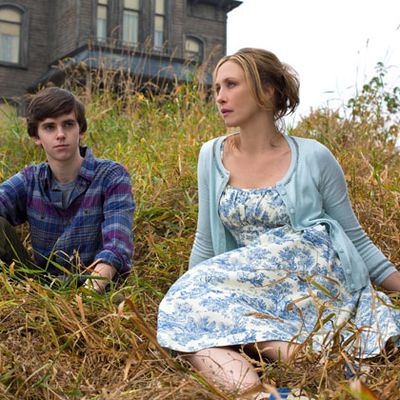
The A&E drama Bates Motel is a critical conundrum, and after watching the first three episodes, IÔÇÖm still not sure how to untangle it.
Created by Anthony Cipriano and executive-produced by Carlton Cuse (Lost) and Kerry Ehrin (Friday Night Lights), Bates Motel is an origin story for, or prequel to, Psycho ÔÇö and yet it isnÔÇÖt. Like Robert BlochÔÇÖs novel and Alfred HitchcockÔÇÖs same-named film, it revolves around a troubled young man named Norman Bates (Freddy Highmore, who played Charlie in Tim BurtonÔÇÖs Charlie and the Chocolate Factory). But where NormanÔÇÖs mother was, um, an absent presence in earlier versions, on this show sheÔÇÖs very much alive, played by Vera Farmiga in a performance that seems at once meticulously studied and disarmingly ÔÇ£realÔÇØ (a Streep-like vibe); Ma Bates has both a name (Norma!) and a complex, often unnerving personality.
The Norma-Norman relationship isnÔÇÖt the showÔÇÖs only deviation from its source, or sources; Bates Motel is mostly deviations, really. ItÔÇÖs set in the present. Norman has an older, tougher half-brother named Dylan Massett (Max Thierrot) ÔÇö his momÔÇÖs son from a previous marriage ÔÇö who gets involved in the local underworld while needling Norma for being a rotten parent. There are hints that NormaÔÇÖs a femme fatale/black widow with more than one brutal crime in her past. Everyone uses a cell phone and communicates via text message, and in one sequence, Norman uses his phoneÔÇÖs camera light as a flashlight to navigate a dark house.
The show isnÔÇÖt shy about indulging retro design and music (the second episode makes deft ironic use of Herp AlpertÔÇÖs ÔÇ£This GuyÔÇÖs in Love With YouÔÇØ). But these touches are spice rather than the whole meal. The show is anchored by a few iconic signifiers from HitchcockÔÇÖs film ÔÇö the motel itself, rebuilt panel-by-panel on location in foggy Vancouver; a classically triangular butcher knife; godÔÇÖs-eye view shots revealing horrors that the ignorant or innocent canÔÇÖt quite spot ÔÇö but the visual style is Modern Cable Drama, with a desaturated color scheme and lots of handheld shots, and the overall feeling is more Twin Peaks than Psycho. This is partly because of the shared locale (David LynchÔÇÖs classic was filmed in visually similar areas of Washington State and Northern California, and thereÔÇÖs a shot in Bates MotelÔÇÖs second episode that seems a deliberate reference to PeaksÔÇÖ title card shot). But itÔÇÖs also a function of the showÔÇÖs format, which turns the motel property and the surrounding community into a darker, kinkier cousin of Peyton Place. ItÔÇÖs a small town, yet big enough to contain a multitude of sins: rape, murder, sexual slavery, drug dealing, you name it. ThereÔÇÖs a Peaks-like tension between buried malevolence and cornball ÔÇ£innocence,ÔÇØ and I was pleasantly surprised by how convincingly Bates Motel sells the latter. This is the kind of series that can have one character tell another, ÔÇ£YouÔÇÖre like a beautiful, deep, still lake in the middle of a concrete world,ÔÇØ while a Coldplay song peals on the soundtrack, and make the moment feel ridiculous, organic and sincere all at once.
IÔÇÖm torn between condemning the series for piggybacking on a classic and promising an origin story it doesnÔÇÖt really care to deliver, and praising it for avoiding the homicidal Muppet Babies formula and pulling a pretty brazen bait-and-switch. More the latter, I suppose ÔÇö for now, anyway. Bates Motel is tangentially connected to Robert Bloch, Alfred Hitchcock, and Psycho; like Norma Bates, it has kept its married name while pursuing its own identity and agenda. ItÔÇÖs as much NormaÔÇÖs show as NormanÔÇÖs. Their relationship ÔÇö which often suggests age-imbalanced, platonic spouses rather than mother-son ÔÇö is the taleÔÇÖs misshapen center of gravity. IÔÇÖve read early reviews claiming that Bates Motel plays up the incestuous undertones in HitchcockÔÇÖs original and in the various sequels and prequels (especially the flashback-driven Psycho IV: The Beginning), but thatÔÇÖs not accurate ÔÇö not quite yet, anyway. ThereÔÇÖs something deep and scary about Norman and NormaÔÇÖs relationship, but only when you stand outside of it; when youÔÇÖre inside with them, it seems quite comfortable. Norma is as attractive-repulsive an antihero as Breaking BadÔÇÖs Walter White. Farmiga, who told one interviewer that she considers herself the thespian version of Mrs. BatesÔÇÖs defense attorney, uncovers layers in the character that are recognizably human, if not exactly sympathetic. Norma uses her boy as slave labor to refurbish the hotel she just bought with NormanÔÇÖs dead fatherÔÇÖs insurance money; sheÔÇÖs not above using flirtation or sex to manipulate local men who might otherwise cause problems for her; she makes her son an accessory to crimes and weighs him with horrible guilt for behaving as any halfway normal teenage boy would. And yet, no matter how flagrantly Norma exploits her boy, we never doubt her love for him, his love for her, her Mildred PierceÔÇôlike determination to make a comfortable place for herself in a manÔÇÖs world, and his loyalty to her vision. All of these qualities make them hard to entirely hate. When Norman sneaks out to attend a party with a beautiful local girl named Bradley (Nicole Peltz) rather than rest up to help his mom with motel renovations, Norma practically climbs up on a cross and nails herself to it; but such masochistic passive-aggressive behavior is balanced by moments of clarity in which Norma sounds almost, well, normal.
ÔÇ£YouÔÇÖre too good for me,ÔÇØ she tells her boy. ÔÇ£IÔÇÖm the worst mother in the world. Look at what your life has been. What good am I doing you?ÔÇØ
ÔÇ£YouÔÇÖre my whole world, my whole life,ÔÇØ he replies. ÔÇ£You always have been. ItÔÇÖs like thereÔÇÖs a cord between our hearts.ÔÇØ
ItÔÇÖll take a big knife to cut it.


